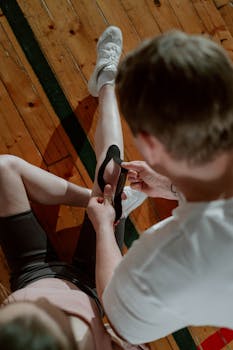
More Pain Management & Rehabilitation Articles
Is Runner’s Knee Causing Your Pain After Running? Discover Effective Treatments Now

After a satisfying run, discovering that you’re suffering from runner knee can be disheartening. Known for causing discomfort and pain around the kneecap, runner knee often affects runners of all levels. This condition, also known as patellofemoral pain syndrome, is common among athletes and can arise from various factors. Understanding its causes and available treatments can help you manage it effectively.
Understanding Runner Knee
Runner knee refers to pain around the kneecap, particularly where it meets the thigh bone. This pain is often exacerbated by running, walking, or climbing stairs. Muscle imbalances, overuse, or improper foot mechanics can contribute to the condition. Runner knee may develop gradually over time, or it can appear suddenly after an intense activity.
Engaging in physical activities such as running without adequate preparation can increase the likelihood of developing run knee problems. It’s crucial to recognize early signs and implement preventive measures to avoid long-term issues.
Causes and Symptoms
Runner knee can have several causes, ranging from biomechanical issues to training habits. Common causes include:
- Overuse: Repetitive movements can irritate the tissues around the kneecap.
- Muscle Imbalances: Weak or imbalanced muscles can put extra stress on the knee joint.
- Improper Footwear: Shoes that do not provide adequate support can affect knee alignment.
- Misalignment: Poor alignment of the kneecap or the lower leg can contribute to inner knee pain when running.
Symptoms often include a dull, aching pain around the front of the knee, difficulty sitting comfortably with bent knees, swelling, or a grinding sensation when the knee moves.
Runner’s Knee Treatment
Addressing runner knee typically involves a combination of therapies that aim to reduce pain and prevent recurrence. Consider the following treatment options:
- **Rest and Activity Modification:** Avoid activities that exacerbate the pain.
- **Ice and Elevation:** Applying ice can help reduce swelling, while elevating the leg can decrease inflammation.
- **Physical Therapy:** Strengthening the surrounding muscles and improving flexibility with a physical therapist can help realign the kneecap.
- Incorporating gradual exercises into your routine to improve overall knee health is key.
- **Footwear Modification:** Ensuring you wear the correct shoes with proper support can alleviate stress on the knees.
- **Medications:** Over-the-counter pain relievers can help manage discomfort temporarily.
It’s essential to consult a healthcare provider to receive a tailored treatment plan based on your specific needs.
Preventing Sore Knees After Running
Prevention is a crucial aspect of managing sore knees after running. Implementing these strategies can help:
- Gradual Training: Increase mileage and intensity slowly to avoid overloading the knees.
- Cross-Training: Engage in low-impact activities, such as cycling or swimming, to give your knees a break.
- Strength Training: Build strength in your quadriceps, hamstrings, and calves to support the knee.
- Proper Warm-Up: Warm up your muscles before running to prevent injuries.
Taking these precautions can help minimize the risk of developing knee pain, allowing you to enjoy running without interruptions.
Additional Support and Resources
For those seeking further information on healthy exercise habits, many resources are available. Exploring educational material from reputable sources can help in understanding and managing conditions like runner knee.
For an in-depth look at knee health and other related topics, the Wikipedia page on knee provides a wealth of information that could be beneficial.
Managing Runner Knee Effectively
In conclusion, runner knee is a manageable condition with the right approach. By understanding the causes and adhering to effective treatment and prevention strategies, you can alleviate symptoms and support your knee health. Remember to listen to your body and adjust activities as needed to prevent further complications. With proper care, you can continue to pursue an active lifestyle while minimizing the impact of runner knee.
- Runner knee can be caused by overuse, muscle imbalances, and improper footwear.
- Treatment options include rest, ice, physical therapy, and proper footwear.
- Prevention involves gradual training, cross-training, and strength exercises.
- Consult healthcare providers for personalized treatment plans.
- Explore reputable sources for more information on knee health.
What is runner’s knee?
Runner’s knee, or patellofemoral pain syndrome, is a condition that causes pain around the kneecap, often experienced by runners and athletes.
How can I treat runner’s knee at home?
Home treatments include rest, ice application, over-the-counter pain relievers, and exercises to strengthen knee-supporting muscles.
Can improper footwear cause knee pain?
Yes, shoes that do not provide adequate support can lead to misalignment and stress on the knee joints, causing pain.
Is it possible to prevent sore knees after running?
Yes, by incorporating gradual training increases, strength exercises, cross-training, and proper warm-up routines, you can prevent knee soreness.
Should I see a doctor for runner’s knee?
If pain persists despite home treatments, it is advisable to consult a healthcare provider for a personalized evaluation and treatment plan.
Other Articles You May Find of Interest...
- Relief from Pain: A Guide to Using DMSO and Safe Dilution Techniques for Topical Application
- Causes and Relief for Rib Cage Discomfort
- Is Subchondral Sclerosis Affecting Your Joint Health?
- Relieving Discomfort: Effective Strategies for Pain in Your Right Forearm
- How Symptoms Help Diagnose Shoulder Impingement Correctly
- Is Your Pain Caused by Tennis Elbow? Find Out with This Simple Test
- The Most Common Causes Behind Neck Discomfort














